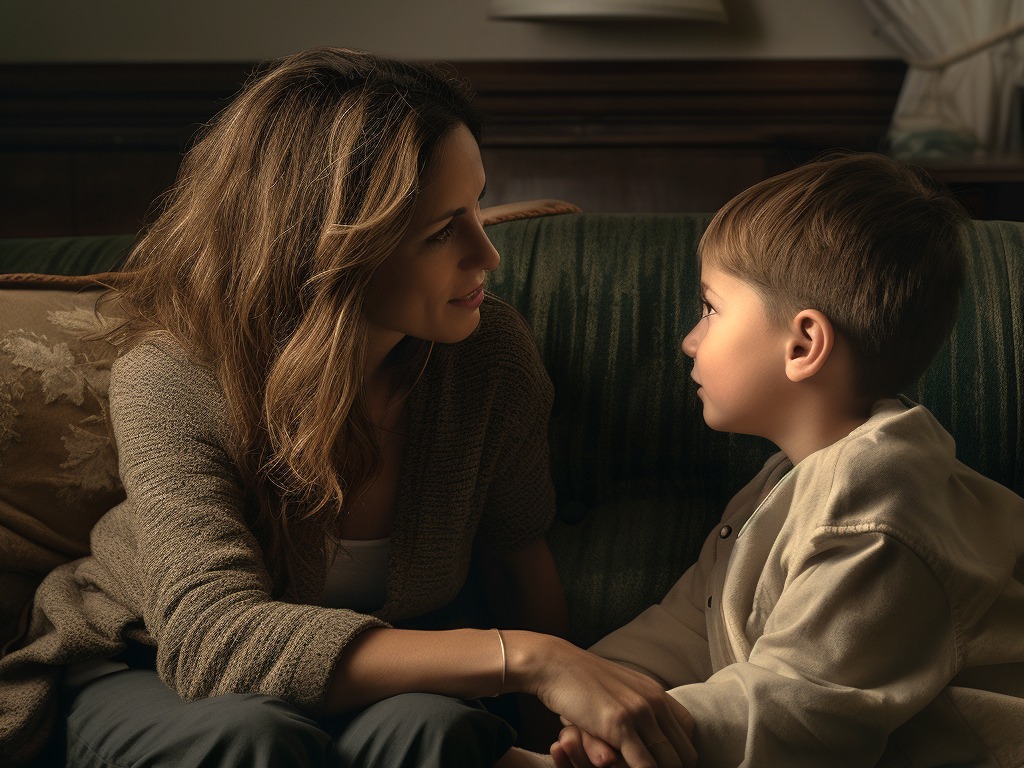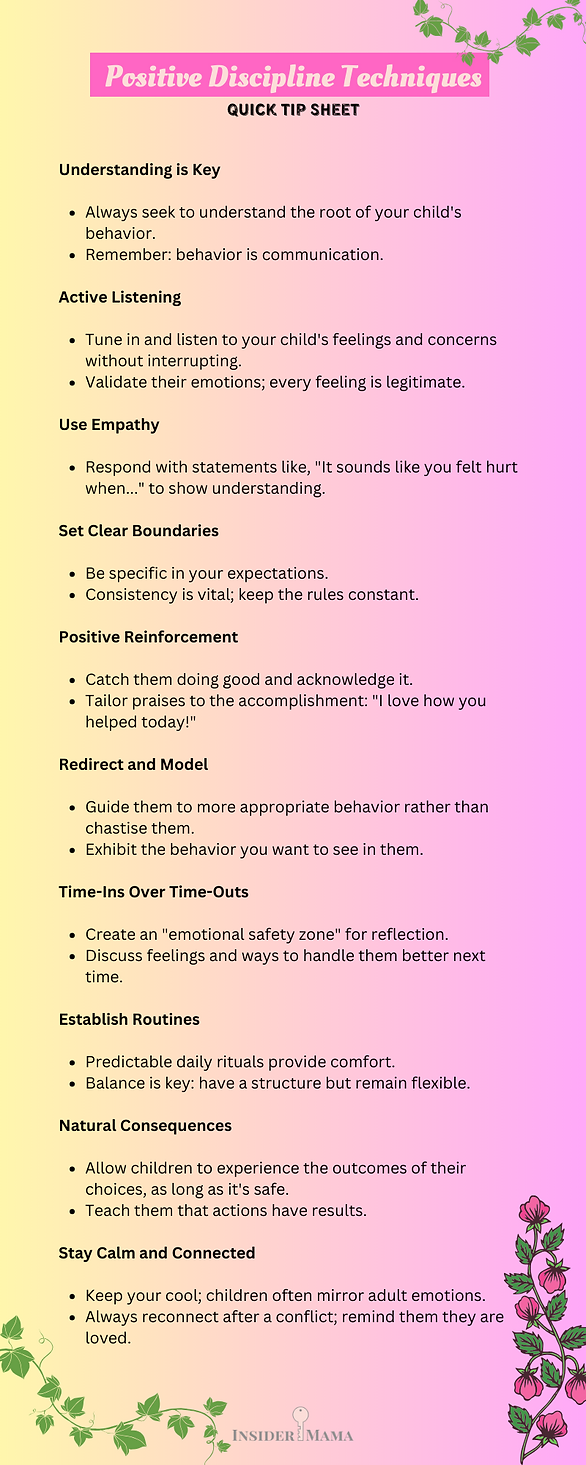Positive discipline is about teaching our kiddos how to behave correctly, without resorting to punishment that can hurt their self-esteem. The idea is simple: Encouraging good behavior with understanding and kindness is more effective than the “time-out” corner. This post will outline several positive discipline techniques that you can start using today.

Positive Discipline Techniques Every Mom Should Know
Understand the “Why” Behind the Behavior
Establish Routines and Rituals
Understand the “Why” Behind the Behavior
When our little ones act out, it can be tempting to focus solely on the behavior we’re seeing. But often, there’s a deeper reason behind that foot-stomping or tearful outburst.
A Child’s Perspective
Imagine being in a world where everything is at least twice your size, including the people you rely on for everything. And imagine you don’t have the vocabulary to express your feelings adequately. Tough, right? For children, frustrations can emerge because they’re processing a huge world with limited tools. Their actions are a language. They’re trying to tell us something, whether it’s “I’m tired” or “I’m overwhelmed” or even “I just need a hug.”
Be an Emotional Detective
To truly master positive discipline techniques, we need to sharpen our detective skills. Look for patterns. Is the tantrum always before nap time? Maybe your little one is acting out more since a new sibling arrived. Once we identify these patterns, we can anticipate and address the root causes instead of merely reacting to behaviors.
Communicate and Validate
Children, just like adults, want to feel understood. When you notice your child getting frustrated, take a moment to communicate. A simple, “It looks like you’re feeling sad because you can’t have that toy. It’s tough, isn’t it?” can make them feel validated. You’re recognizing their feelings, which can be the first step to calming down.
Mom-tip: Create a “feelings chart” with various emotions displayed. When your child is struggling, point to the chart and ask them to show you how they feel. It can be a fantastic way for them to communicate without words.
Remember the Basics
Sometimes, the root causes are pretty straightforward. The three main culprits are often hunger, fatigue, and overstimulation. Having a regular routine can help ensure your child is fed, rested, and not overwhelmed. This is not about having a strict regimen but about creating a predictable environment where your child feels secure.
When we shift our perspective from merely addressing the behavior to understanding the underlying cause, we can connect more deeply with our children. This approach allows us to guide them with empathy, helping them grow emotionally while still setting clear and loving boundaries. It’s all about listening with our eyes and our hearts, ensuring our kiddos feel heard and understood.
Connect Before You Correct: Positive Discipline Technique
Why Connection Matters
Think about it: When you’re upset or frustrated, how do you feel when someone immediately starts telling you what you did wrong? Defensive, probably. Maybe even a little hurt. Our kids are no different. By first establishing a connection, we create a safe space where they feel understood and are more receptive to our guidance.
The Power of Presence
Before diving into correction, take a deep breath. (Yes, moms need timeouts too!) Then, get down on their level—literally. This simple act makes you less intimidating and more approachable. When you make eye contact and perhaps touch their arm or shoulder gently, you’re sending a clear message: “I’m here with you, and we’re in this together.”
Use Empathetic Language
Start with a phrase that shows you understand their feelings. Saying things like, “I see you’re really frustrated right now,” or “It seems like you’re feeling left out,” can be a game-changer. It’s a way of telling them, “Hey, I get you.”
The “Heart-to-Heart” Approach
Sometimes, all it takes is a moment of shared understanding. Sit down with your child, perhaps in a favorite cozy spot, and chat about what happened. Not a lecture, just a chat. Ask them questions like, “What made you feel like doing that?” or “How do you think [the other person] felt when that happened?” Encouraging them to reflect on their actions while feeling supported can lead to genuine, lasting insights.
Mom-tip: After connecting, when it’s time to correct, frame it in a positive way. Instead of saying, “We don’t snatch toys,” try “We share our toys because it makes everyone happy.”
By connecting before correcting, we’re not just addressing a single misbehavior. We’re nurturing our child’s emotional intelligence, fostering empathy, and teaching them to reflect on their actions—all while strengthening our bond with them. It’s a win-win approach, ensuring our little ones understand that, even when they mess up, they’re loved and supported.
Positive Discipline Techniques that Offer Choices
The world can sometimes feel big and overwhelming for our little ones. They’re surrounded by giants who decide what they eat, when they sleep, and even what they wear. So it’s no wonder they occasionally decide to stage a mini-rebellion by asserting some control. One brilliant way to channel this natural desire for autonomy in a positive direction is by offering choices.
Why Choices Matter
Giving choices empowers kids. It makes them feel they have a say in their lives and can make decisions. This not only boosts their self-esteem but also teaches responsibility. After all, with choices come consequences, and learning that from an early age is golden.
Making It Age-Appropriate
The key is to provide choices suitable for their age. For toddlers, it might be as simple as, “Would you like the blue cup or the red cup?” For older kids, you can offer more complex decisions, like, “Would you like to do your homework before or after your snack?”
Limiting the Options
While offering choices is great, presenting too many can be overwhelming. Ever stood in the cereal aisle completely stumped by the 50 varieties of granola? Yeah, kids feel that way too. So, keep it simple. Two or three options are usually more than enough to give them a sense of control without overwhelming them.
Stay in Control
This isn’t about letting your child rule the roost. It’s about giving them controlled choices. For example, if it’s cold outside, it’s not about choosing between wearing a coat or not. It’s about selecting which warm coat to wear.
Mom-tip: When introducing choices, make sure you’re okay with any option they might pick. If you’re not comfortable with your child wearing their superhero costume to grandma’s, it’s best not to offer it as a choice in the first place!
Celebrate Their Choices
When they make a choice, acknowledge it. A simple, “You chose the red cup today, great choice!” or “I noticed you decided to do your homework before snack time, that’s responsible!” can go a long way in validating their decisions.
Offering choices is a mini masterclass in decision-making for our kids. It’s a stepping stone to them becoming independent, thoughtful individuals. And while there might be days they choose mismatched socks or insist on reading the same book for the 100th time, remember: it’s not about the socks or the book. It’s about the confidence and sense of self they’re building—one choice at a time.
Set Clear Boundaries
Boundaries. The invisible lines that help create harmony in our homes. Setting boundaries for our kids might seem daunting, but it’s a bit like planting a garden. You set the borders, sow the seeds of understanding, water with consistency, and soon enough, you have a blossoming child who understands the value of limits.
The Importance of Boundaries
Boundaries offer kids a sense of security. While they might push against them occasionally (or, let’s be real, often), deep down, these limits assure them that someone is looking out for them.
Be Clear and Specific
General instructions can be confusing for kids. Instead of saying, “Be good,” which can be vague, try specific guidelines like, “We use gentle hands with our friends.” This gives them a clear picture of the expected behavior.
Consistency is Key
Imagine learning a new game where the rules keep changing. Frustrating, right? For kids, boundaries that keep shifting can be just as confusing. So, once you’ve set a boundary, try to be consistent in upholding it. It sends the message that these aren’t arbitrary rules but essential guidelines for everyone’s well-being.
Involve Them in the Process
For older kids, involving them in the boundary-setting process can be beneficial. Discussing and deciding on rules together can give them a sense of ownership and make them more invested in adhering to them. Plus, it’s a fantastic opportunity for them to practice negotiation skills—preparing them for all those future debates in the school’s model UN!
Stay Calm and Kind When Reinforcing
Every gardener knows that sometimes, plants grow outside their designated spaces. Similarly, kids will occasionally test and overstep boundaries. When they do, calmly and kindly remind them of the set limits. Your calm demeanor reassures them that the misstep hasn’t rocked the boat but is simply a momentary detour.
Mom-tip: Use natural consequences when boundaries are crossed. If they misuse a toy, perhaps they lose the privilege of playing with it for a set time. This teaches them that actions have consequences without resorting to punitive measures.
Setting clear boundaries for our little ones might seem tough at first, but the rewards are immense. Not only do they create a harmonious household, but they also teach our kids essential life skills like responsibility, self-control, and respect.
The Magic of Positive Reinforcement as a Discipline Technique
At its heart, positive reinforcement is about recognizing and rewarding good behavior.
Why Positive Reinforcement Works
Think about your own life. When someone praises you for a job well done, don’t you feel motivated to keep doing well? Kids are no different. They thrive on recognition. By focusing on and reinforcing their good behaviors, we’re steering them toward repeating those actions in the future.
Spotlight on the Good Stuff
Our natural instinct might be to react when things go wrong. But what if we flipped the script? Instead of catching them in the act of mischief, catch them in the act of being awesome. Did they share a toy without being told? Spotlight on that! Did they finish their homework without fuss? Double spotlight!
Different Strokes for Different Folks
Positive reinforcement doesn’t always mean showering them with gifts. It can be a smile, a pat on the back, or an enthusiastic “Great job!” And let’s not forget, each child is unique. While one might beam with a word of praise, another might feel on top of the world with an extra story at bedtime. Discover what resonates most with your child.
Keep It Genuine
Kids have an uncanny ability to spot insincerity a mile away. So, while it’s great to praise them, make sure it’s genuine. Over-the-top praises for minor achievements can sometimes feel disingenuous. Tailor your compliments to fit the accomplishment.
Chart Their Progress
Consider setting up a positive behavior chart where they get a star or sticker for good behavior. Once they accumulate a certain number, maybe they get a special treat or privilege. It’s a visual, tangible way for them to see the results of their good choices.
Mom-tip: Try to be specific with your praise. Instead of a general “good job,” say something like, “I noticed you helped your sister tie her shoes. That was very kind of you!”
Positive reinforcement is like sunlight for plants. Just as plants lean towards the sun, growing stronger and healthier, kids lean into positive reinforcement, growing more confident and self-assured. By celebrating their successes, no matter how small, we’re not just nurturing good behavior. We’re also cultivating their self-worth and confidence.
Redirecting and Modeling
Ever watched a magician expertly divert the audience’s attention so they can pull off an impressive trick? Redirecting is a bit like that but with less smoke and mirrors and more love and guidance. Combine that with modeling—the art of showing instead of just telling—and you’ve got yourself a dynamic duo of positive discipline techniques.
The Art of Redirection
Kids are naturally curious, and sometimes this curiosity leads them down a path we’d rather they didn’t explore. Like drawing on walls instead of paper. Instead of reprimanding, try redirecting. “I see you love drawing! Let’s use this big sheet of paper instead of the wall.”
Why Redirection Works
When we redirect, we’re doing two things. We’re acknowledging their interests and channeling them in a more appropriate direction. It’s like saying, “I see you, and I value your interests. Let’s find a better way to express them.”
Modeling: The Living Example
Remember the age-old adage, “Do as I say, not as I do”? Well, kids are more likely to flip that script. They often emulate what they see. Modeling is about being the behavior we hope to inspire in our children. If we want them to be kind, patient, and understanding, we need to display those qualities ourselves.
Practice Makes Perfect
Just like mastering any skill, effective redirection and modeling take practice. Sometimes, you forget to model patience or miss an opportunity to redirect. It’s okay! Parenting is a journey with many chances for do-overs.
Mom-tip: For modeling, involve your child in day-to-day positive behaviors. If you’re writing a thank-you note, invite them to scribble a little message or drawing. If you’re practicing meditation or deep breathing, invite them to join for a minute or two. Make it a shared experience.
Redirecting and modeling are about steering our little ones in the right direction and showing them the path. It’s a dynamic blend of guidance and demonstration, a dance where we lead by example and gently guide their steps when they stray.
Time-Ins Instead of Time-Outs
The term “time-out” probably conjures up images of a sad child sitting alone in the corner, feeling isolated and confused. But what if we swapped that lonely corner for a comforting space and the isolation for introspection? Welcome to the world of “time-ins.”
Understanding Time-Ins
Time-ins are a warmer, more constructive alternative to the traditional time-out. Instead of sending a child away, the focus is on bringing them closer, helping them understand their feelings, and guiding them towards better choices.
The Emotional Safety Zone
The key to an effective time-in is creating an “emotional safety zone.” It’s a designated cozy spot, filled with comforting items like soft pillows, a plush toy, or calming books. This space isn’t about isolation, but introspection.
Navigating the Storm
Imagine being caught in a storm of emotions and not knowing how to find shelter. That’s often what a meltdown feels like for kids. Sit with your child (if they’re comfortable) during a time-in and help them navigate toward their feelings. You’re their emotional weather reporter, helping them understand the storm and guiding them towards calmer skies.
Open Dialogue
Use this time to chat gently about what happened. Start with empathy, “I can see you’re really upset. Do you want to talk about it?” The goal is to understand the root cause of the behavior, not just address the surface tantrum.
Deep Breathing and Calming Techniques
Introduce simple deep breathing exercises or calming techniques. A favorite one is the “balloon technique,” where you encourage your child to take a deep breath in, imagining their belly is a balloon filling up with air, and then slowly exhale, deflating the balloon. It’s a fun and effective way to introduce kids to the calming power of breath.
Mom-tip: Once the storm has passed, and they’re feeling calmer, encourage your child to think of alternative ways they could have reacted. It’s not about placing blame but about fostering problem-solving skills.
Time-ins aren’t just a discipline strategy; they’re a lesson in emotional intelligence. By choosing to engage, empathize, and educate during these heated moments, we’re teaching our children to recognize, understand, and manage their emotions.
Establish Routines and Rituals
For children, having a predictable flow to their day provides a soothing rhythm, setting them up for success and reducing the chances of meltdowns.
The Comfort of Knowing
Imagine being dropped into a foreign country without a map or understanding of the language. Daunting, right? For children, the world can sometimes feel this way. Routines offer them a predictable “map” of their day, so they know what to expect next.
Start Simple
Routines don’t have to be elaborate. Start with small daily rituals. It could be as simple as reading a book before bedtime, singing a particular song during bath time, or setting a specific day for a family game night.
Flexibility within Framework
While routines provide a framework, it’s essential to have some flexibility. Life is unpredictable. Sometimes, the bedtime story might be longer, or family game night might need to shift to another day. The key is to strike a balance between predictability and adaptability.
Visual Aids Can Help
Consider creating a visual daily schedule for younger children. Fun illustrations showcasing different activities, like a drawing of a toothbrush for morning brush time or a book for bedtime stories, can make routines exciting and easy to follow.
Making Rituals Special
Beyond routines, family rituals can create lasting memories and foster a sense of belonging. It might be a Saturday morning pancake-making session or a yearly camping trip. These rituals become cherished memories and form the fabric of your child’s childhood.
Mom-tip: Involving kids in the creation of routines can be both fun and educational. Let them help decide the order of activities or come up with ideas for new family rituals. Ownership of the routine can boost their enthusiasm for following it.

Final Thoughts on Positive Discipline Techniques
Our parenting journey may be filled with unexpected detours, wild tantrums, and those “Oops, I did it again!” moments. But with the right positive discipline techniques, we can pave the way for a smoother ride.



